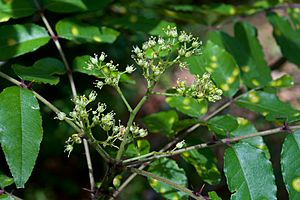Hercules' club facts for kids
Quick facts for kids Hercules' club |
|
|---|---|
 |
|
| Xanthophyllum clava-herculis (Hercules' club) | |
| Conservation status | |
| Scientific classification | |
| Genus: |
Zanthoxylum
|
| Species: |
clava-herculis
|
 |
|
The Hercules' club tree, also known as pepperwood or southern prickly ash, is a spiny tree or shrub. It grows naturally in the southeastern United States. This unique plant gets its name from the distinctive, spiky, club-like bumps that cover its bark.
This tree can grow quite tall, usually reaching between 10 to 17 meters (about 33 to 56 feet). It's a fascinating part of the forest, providing food and shelter for many animals.
Contents
What Does the Hercules' Club Tree Look Like?
The Hercules' club tree has thick, corky bumps on its bark. These bumps are about 2 to 3 centimeters (1 inch) long and have sharp spines. This is why it's called "Hercules' club"—it looks like a strong, spiky weapon!
Its leaves are smooth and feel a bit like leather. They are made up of many smaller leaflets, usually 7 to 19 of them. Each leaf can be 20 to 30 centimeters (8 to 12 inches) long, with each leaflet being about 4 to 5 centimeters (1.5 to 2 inches) long.
Flowers and Fruit
The tree has small, white flowers that grow in large clusters. Each flower is only about 6 to 8 millimeters (a quarter of an inch) wide and has 3 to 5 petals. Some trees have only male flowers, and other trees have only female flowers.
After the flowers, the tree produces small, round fruits. These fruits are about 6 millimeters (a quarter of an inch) across and have a rough surface. Inside, they hold several tiny black seeds.
Why Is It Called the "Toothache Tree"?
The Hercules' club tree is sometimes called the "toothache tree" or "tingle tongue." This is because if you chew on its leaves, bark, or twigs, it makes your mouth, tongue, teeth, and gums feel tingly and numb.
Native Americans and early settlers discovered this special quality. They used parts of the tree to help relieve toothaches. It was a natural way to numb the pain before modern medicines were available.
Where Does the Hercules' Club Tree Grow?
This tree loves lots of water and sunlight. It grows best in open areas or along the edges of forests. The Hercules' club tree has a rounded shape at the top, like a big green dome.
Life Cycle and Reproduction
The fruit of the Hercules' club tree is a tasty snack for birds. When birds eat the fruit, the seeds pass through their bodies unharmed. This helps the seeds spread to new places.
New Hercules' club trees often start growing in spots where birds like to rest. You might find young trees sprouting along fence lines or at the edge of wooded areas. This is how the tree reproduces and spreads its population.
Who Lives on This Tree?
The Hercules' club tree is an important home and food source for many creatures.
- Deer enjoy eating its leaves.
- Birds feast on its small fruits.
- Several types of insects also live on this tree. For example, the large and colorful Giant swallowtail butterfly (Papilio cresphontes) uses it as a host plant. This means the butterfly lays its eggs on the tree, and its caterpillars eat the leaves.
- Another insect that lives on the tree is the leaf beetle called Derospidea brevicollis.
Similar-Looking Trees
Sometimes, the name Hercules' club is also used for another tree called Aralia spinosa. This tree also grows in eastern North America.
However, it's easy to tell the two trees apart. The Aralia spinosa has very large leaves that are divided into many smaller parts. It also has very big scars on its branches where old leaves used to be. The Hercules' club tree (Zanthoxylum) has simpler leaves and different leaf scars, making them easy to distinguish if you know what to look for.
Images for kids



